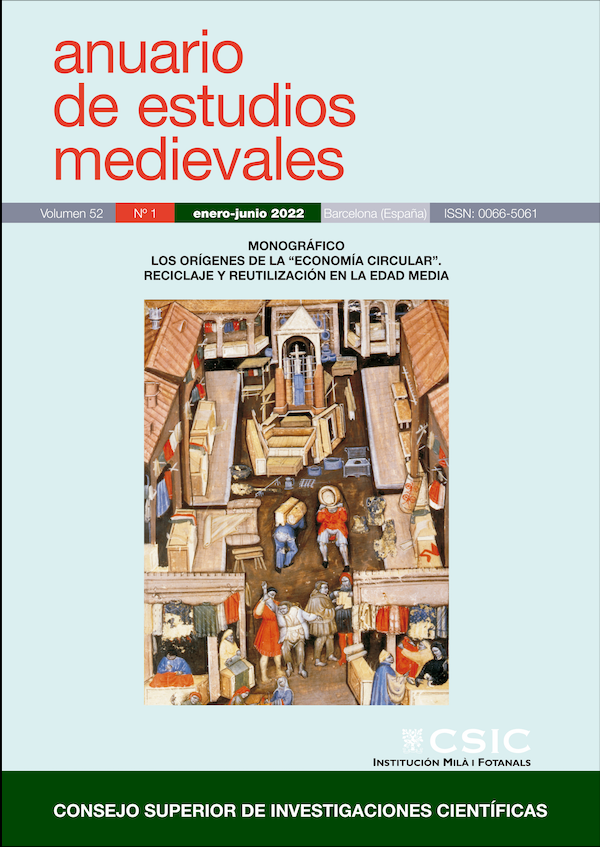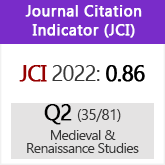Circular Economy and “Circular Expertise”: The Second-hand Market and Professional Estimators in Fifteenth-Century Florence
DOI:
https://doi.org/10.3989/aem.2022.52.1.10Keywords:
circular economy, second-hand market, Florence, fifteenth century, estimators, counterfeits, reuse & upcyclingAbstract
Making use of statutes as well as of a particular group of corporate sources, two registers entitled Deliberazioni e Statutaria, both promulgated in Florence by the Arte dei rigattieri (secondhand dealers) in the Late Middle Ages, this essay explores a crucial facet of circular economy, that of the regulation of the second-hand market in the 15th century. Control was operated through the activity of appraisers, sellers themselves, whom the Arte entrusted with the task of undertaking all necessary assessments of used garments that might have been required during daily transactions by different parties. By shedding light on key information like the fabrics and the fashion of secondhand clothing, this essay analyses all aspects of circular trade, from those prohibited by law, such as counterfeiting, to those adopted to facilitate business, such as the presence of officially appointed estimators.
Downloads
References
Archivio di Stato di Firenze, Arte dei Rigattieri e Linaioli, 7.
Archivio di Stato di Firenze, Arte dei Rigattieri Linaioli e Sarti, Deliberazioni e Statutaria dei Consoli, 13.
Archivio di Stato di Firenze, Arte dei Rigattieri Linaioli e Sarti, Deliberazioni e Statutaria dei Consoli, 14.
Sartini, Ferdinando (1940-1948), Statuti dell'Arte dei Rigattieri e Linaioli di Firenze (1296-1340), Florence, Le Monnier.
Ammannati, Francesco (2020), Per filo e per segno. L'Arte della lana a Firenze nel Cinquecento, Florence, FUP. https://doi.org/10.36253/978-88-6453-983-6
Antenhofer, Christina (2016), O per honore, o per commodo mio: Displaying Textiles at the Gonzaga Court (Fifteenth-Sixteenth Centuries), in Europe's Rich Fabric. The Consumption, Commercialisation, and Production of Luxury Textiles in Italy, the Low Countries and Neighbouring Territories (Fourteenth-Sixteenth Centuries), Farnham, Ashgate, pp. 35-68.
Carboni, Mauro; Muzzarelli, Maria Giuseppina (eds.) (2012), In pegno. Oggetti in transito tra valore d'uso e valore di scambio (secoli XIII-XX), Bologna, Il Mulino.
Carpegna Falconieri, Tommaso di (2020), Nel labirinto del passato. 10 modi di riscrivere la storia, Bari, Laterza.
Cavaciocchi, Simonetta (ed.) (1993), La seta in Europa. Sec. XIII-XX. Atti della Ventiquattresima Settimana di Studi. 4-9 maggio 1992, Prato, Istituto Internazionale di Storia economica "F. Datini".
Ciuffetti, Augusto (2015), Il commercio degli stracci da carta nello Stato pontificio nei secoli XVIII e XIX tra politiche economiche e pratiche mercantili, "Mélanges de l'École française de Rome - Italie et Méditerranée modernes et contemporaines" 127/1, pp. 109-120. https://doi.org/10.4000/mefrim.2161
Cohen, Elisabeth; Cohen, Tom (2010), Postscript: charismatic things and social transaction in Renaissance Italy, "Urban History" 37/3, pp. 474-482. https://doi.org/10.1017/S0963926810000581
Collier Frick, Carole (2002), Dressing Renaissance Florence: families, fortunes, and fine clothing, Baltimore, The Johns Hopkins University Press.
Damen, Mario J. M. (2007), Gift exchange at the court of Charles the Bold, in Boone, Marc; Howell, Martha (eds.), in In But not of the Market.
Exchanging Movables in Late Medieval Society and Early Modern Economy, Brussels, Koninklijke Vlaamse Academie, pp. 81-99.
Denjean, Claude; Feller, Laurent (eds.) (2013), Expertise et valeur des choses au Moyen Age. I. Le besoin d'expertise, Madrid, Collection de la Casa de Velazquez.
D'Errico, Rita (1994), Il prestito tra privati a Roma attraverso le fonti notarili e fiscali del XVIII e XIX secolo, in Roma Moderna e Contemporanea, Roma tra fine Settecento e inizi Ottocento, vol. II, Rome, Università degli Studi Roma Tre - CROMA, pp. 139-151.
Edler de Roover, Florence (1999), L'arte della seta a Firenze nei secoli XIV e XV, Florence, Olschki.
Feller, Laurent (2014), Évaluer les objets de luxe au Moyen Âge, "Anales de Historia del Arte" 24, pp. 133-146. https://doi.org/10.5209/rev_ANHA.2014.48273
Feller, Laurent; Rodriguez, Ana (eds.) (2013), Objets sous contraintes. Circulation des richesses et valeur des choses au Moyen Âge, Paris, Éditions de la Sorbonne. https://doi.org/10.4000/books.psorbonne.26763
Feller, Laurent; Rodriguez, Ana (eds.) (2016), Expertise et valeur des choses au Moyen Age. II. Savoirs, écritures, pratiques, Madrid, Collection de la Casa de Velazquez. https://doi.org/10.4000/books.psorbonne.40861
Fontaine, Laurence (2008), L'économie morale, pauvreté, crédit et confiance dans l'Europe préindustrielle, Paris, Gallimard.
García Marsilla, Juan Vicente (2016), Expertos de lo usado. Pellers, ferrovellers y corredors de coll en la Valencia medieval, in Feller, Laurent; Rodriguez, Ana (eds.), Expertise et valeur des choses au Moyen Age. II. Savoirs, écritures, pratiques, Madrid, Collection de la Casa de Velazquez, pp. 343-358.
García Marsilla, Juan Vicente (2017), Dressing the King and the Beggar: The Various Levels of the Textile Market and their Prices in Medieval Valencia (13th-15th Centuries), in I prezzi delle cose nell'età preindustriale. The Prices of Things in Pre-industrial Times, Prato, FUP , pp. 57-86.
García Marsilla, Juan Vicente; Navarro Espinach, Gérman; Vela Aulesa, Carles (2015), Pledges and Auctions: the Second-Hand Market in the Late Medieval Crown of Aragon, in Il commercio al minuto. Domanda e offerta tra economia formale e informale. Secc. XIII-XVIII. Retail Trade. Supply and demand in the formal and informal economy from the 13th to the 18th century: selezione di ricerche, Florence, FUP, pp. 295-317 (Atti delle "Settimane di Studi" e altri Convegni, 46).
Gazeau, Véronique (ed.) (2011), Experts et expertise au Moyen Age. Consilium quaeritur a perito. Actes du XLIIe congrès de la SHMESP, Oxford, Éditions de la Sorbonne.
Geltner, Guy (2019), Roads to Health. Infrastructure and Urban Wellbeing in Later Medieval Italy, Philadelphia, UPP. https://doi.org/10.9783/9780812296310 PMid:30556517 PMCid:PMC8670759
Goldthwaite, Richard Allen; Mandich, Giulio (1994), Studi sulla moneta fiorentina (secoli XIII-XVI), Florence, Olschki.
Hoshino, Hidetoshi (1980), L'arte della lana in Firenze nel basso Medioevo. Il commercio della lana e il mercato dei panni fiorentini nei secoli XIII-XV, Florence, Olschki.
Hoshino, Hidetoshi (2001), Industria tessile e commercio internazionale nella Firenze del tardo Medioevo, Florence, Olschki.
Krohn, Deborah (2003), Taking Stock: Evaluation of Works of Art in Renaissance Italy, in The Art Market in Italy (15th-17th Centuries). Il mercato dell'arte in Italia (secc. XV-XVII), Modena, Franco Cosimo Panini Editore, pp. 203-211.
Martinat, Monica (2008), L'économie moderne entre justice et marché, in L'économie antique, une économie de marche?, Paris, Société des amis de Iacob Spon, pp. 253-262.
Meneghin, Alessia (2015), The livery of a Florentine employee in the fifteenth century: the rewards of a lifetime of service, "History of Retailing and Consumption" 1/1, pp. 47-62. https://doi.org/10.1080/2373518X.2015.1015820
Meneghin, Alessia (2020), The Social Fabric of Fifteenth-Century Florence. Identities and Change in the World of Second-Hand Dealers, New York - London, Routledge. https://doi.org/10.4324/9780367809690
Molà, Luca (2000), The Silk Industry of Renaissance Venice, Baltimore, John Hopkins University Press.
Monier, Véronique; Tinetti, Benoît; De Prado Trigo, Alvaro; Ax, Christine; Medhurst, James; Mitsios, Andreas (2016), Study on socioeconomic impacts of increased reparability, Brussels, European Commission.
Montalvo, Carlos; Peck, David; Rietveld, Elmer (2016), A longer lifetime for products: Benefits for consumers and companies, Brussels, Policy Department for Economic and Scientific Policy - European Parliament.
Muzzarelli Maria Giuseppina; Campanini, Antonella (eds.) (2003), Disciplinare il lusso. La legislazione suntuaria in Italia e in Europa tra medioevo ed età moderna, Rome, Carocci.
Pepke, Hannelore (2017), À la recherche du prix raisonnable. Le calcul des prix de denrées et de produits à Dijon au début du XV e siècle, in I prezzi delle cose nell'età preindustriale. The Prices of Things in Preindustrial Times, Prato, FUP, pp. 87-105.
Ricchetti, Marco (ed.) (2017), Neomateriali nell'economia circolare. Moda, Milan, Edizioni Ambiente.
Sergi, Giuseppe (2005), L'idea di Medioevo. Fra storia e senso comune, Rome, Donzelli.
Stabel, Peter (2007), Negotiating Value: the Ethics of Market Behavior and Price Formation in the Late Medieval Low Countries, in In But not of the Market. Exchanging Movables in Late Medieval Society and Early Modern Economy, Brussels, Koninklijke Vlaamse Academie, pp. 53-70.
Tognetti, Sergio (1995), Prezzi e salari nella Firenze tardomedievale: un profilo, "Archivio Storico Italiano" 153/2, pp. 263-333.
Tognetti, Sergio (2002), Un'industria di lusso al servizio del grande commercio. Il mercato dei drappi serici e della seta nella Firenze del Quattrocento, Florence, Olschki.
Welch, Evelyn (2002), The Art of Expenditure: The Court of Paola Malatesta Gonzaga in Fifteenth-Century Mantua, "Renaissance Studies" 16/3, pp. 306-317. https://doi.org/10.1111/1477-4658.00018
Zupko, Ronald Edward; Laures, Robert Anthony (1996), Straws in the Wind: Medieval Urban Environmental Law, The case of Northern Italy, Abingdon, Taylor & Francis.
https://www.ellenmacarthurfoundation.org/circular-economy/what-is-thecircular-economy [accessed: 21/03/2021].
https://www.rinnovabili.it/economia-circolare/mercato-dell-usato/ [accessed: 22/03/2021].
Downloads
Published
How to Cite
Issue
Section
License
Copyright (c) 2022 Consejo Superior de Investigaciones Científicas (CSIC)

This work is licensed under a Creative Commons Attribution 4.0 International License.
© CSIC. Manuscripts published in both the printed and online versions of this Journal are the property of Consejo Superior de Investigaciones Científicas, and quoting this source is a requirement for any partial or full reproduction.All contents of this electronic edition, except where otherwise noted, are distributed under a “Creative Commons Attribution 4.0 International” (CC BY 4.0) License. You may read here the basic information and the legal text of the license. The indication of the CC BY 4.0 License must be expressly stated in this way when necessary.
Self-archiving in repositories, personal webpages or similar, of any version other than the published by the Editor, is not allowed.















